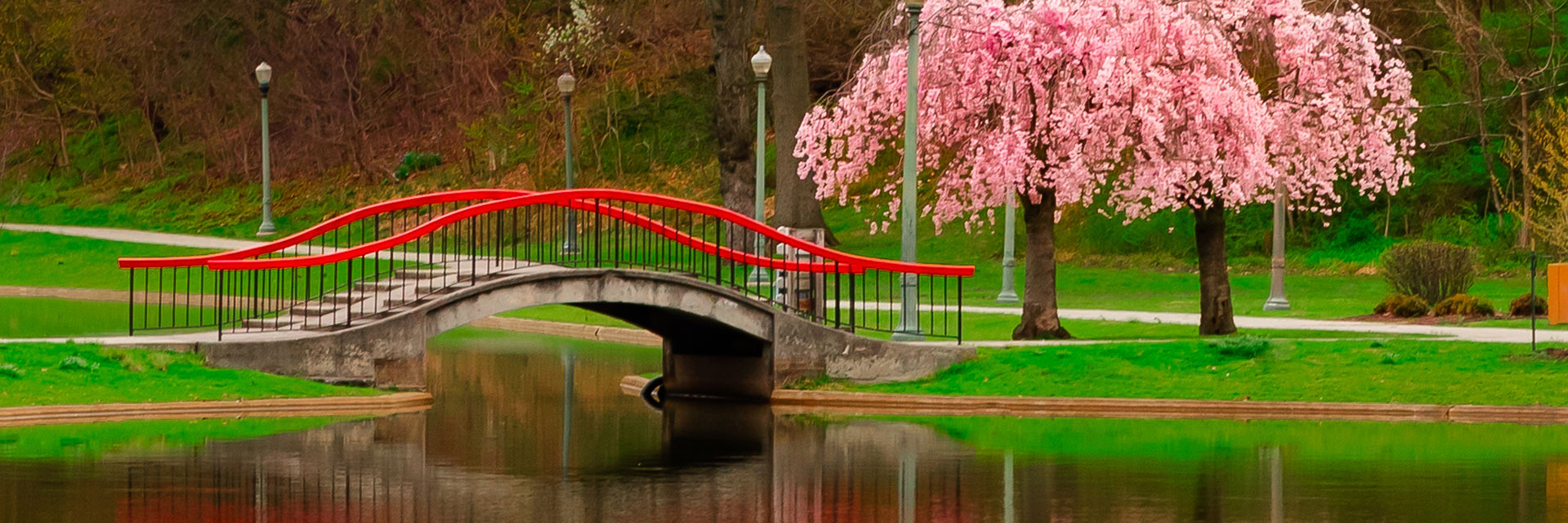Three leading lights left an indelible mark on the Commonwealth’s landscapes and open spaces.
In the 20th century, the Commonwealth continued to have a profound impact on the nation’s horticulture thanks to three very different women: Rachel Carson, Pearl S. Buck, and Mira Lloyd Dock. You can connect with their stories at three locations around the state.
Carson’s Clarion Call
Rachel Carson isn’t known as a gardener, but she did deepen our understanding of how the natural world works. In one slim, carefully researched book, Carson sounded an alarm that has reverberated ever since.
The Rachel Carson Homestead, a farm in Springdale, Allegheny County, where she grew up, was listed in the National Register of Historic Places in 1976. Along with preserving Carson’s birthplace, the nonprofit Rachel Carson Homestead Association aims “to design and implement environmental education programs aligned with Rachel Carson’s environmental ethic and her sense of wonder.”
Born in 1907, Carson often spent her free time exploring the hills and fields surrounding her family’s property. Carson’s other passion was writing. At age 10, one of her stories was published in a children’s magazine. She later enrolled as an English major at Pennsylvania College for Women in Pittsburgh (now known as Chatham University), but soon shifted her focus to biology. Carson continued her studies at Woods Hole Oceanographic Institute in Massachusetts and at Johns Hopkins University, earning a master’s degree in zoology in 1932.
The scientist then put her writing skills to work for the U.S. Bureau of Fisheries; in 1935, she was the second woman hired by the agency. For the next 15 years, Carson enlightened the public about the marine ecosystem through printed materials and a radio program titled “Romance Under the Water.” She was eventually promoted to editor-in-chief of all publications for the U.S. Fish and Wildlife Service.
During this time, Carson began publishing books. Her second, The Sea Around Us (1951), earned a National Book Award for non-fiction. Then she discovered the topic that would bring her to prominence and help launch a movement.
Dichlorodiphenyltrichloroethane (DDT) is a powerful chemical that was used to control lice by the U.S. military during World War II. After the war, the manufacturer began marketing it as a pest control product for agriculture and horticulture. Carson realized that the insecticide was having a destructive impact on species all the way up the food chain, including bald eagles and humans. Silent Spring, her book about the damage caused by DDT and other pesticides, was published in 1962 and quickly became a bestseller. It sparked public outcry about the indiscriminate use of insecticides and inspired the creation of the Environmental Protection Agency (EPA) in 1970.
Today, the agency evaluates agricultural chemicals and sets standards for their application. At the same time, a growing number of organic farmers and gardeners are choosing to tend their crops without any insecticides, inspired by Carson’s insights into the dangers they pose to people and wildlife.
For more information and to plan a visit to Carson’s family home, head to the Rachel Carson Homestead website.

East-West Connection
Author, children’s advocate, and gardener Pearl S. Buck had deep roots in China that gave focus to her life’s work, but she spent much of her adult life in Pennsylvania. At her home in Bucks County — now a National Historic Landmark — she surrounded herself with living reminders of her childhood.
The Pearl S. Buck House features two greenhouses that are home to 26 different varieties of camellias, a native plant of China that became Buck’s favorite flower. A water garden she designed contains rare lotus, lily pads, papyrus, and goldfish. While the site is open daily year round, the property is at its peak of color when the gardens bloom in spring and summer. Late winter is the best time to see the camellia collection in full color in the greenhouses. Beyond Buck’s own landscape, plant breeders have named four flower varieties in her honor: a yellow rose, an apricot sweet pea, a peony, and a crimson camellia.
While this place in Bucks County preserves her legacy, Buck’s life was a global affair. Born in 1892 to parents who were working as missionaries in China, she spent much of her youth among the locals, learning about their lives and struggles. She left China to attend Randolph-Macon Women’s College in Lynchburg, Virginia. She returned to China to help care for her aging mother and in 1917 married John Lossing Buck, an American agricultural missionary. The couple lived in a small town in northern China that became the setting for The Good Earth, which won the Pulitzer Prize in 1932 and remained on the bestseller list for 21 months. In 1938, she became just the second American — and first woman from the U.S. — to be awarded the Nobel Prize for Literature.
When a civil war between Nationalists and Communists engulfed China in 1934, Buck returned to the United States. She subsequently divorced Lossing Buck, married her publisher Richard Walsh, and purchased Green Hills Farm in Perkasie, about 30 miles north of Philadelphia. There, the couple raised a large international family that included seven adopted children and several foster children.
Buck kept her connection to China alive through the gardens around her home. In My Several Worlds, an autobiography published in 1954, she wrote, “For myself, I am indifferent to jewels and personal adornment, but I must have roses and a vegetable garden, and some years ago I indulged myself to include camellias, for these flowers, formal and exquisite, are Chinese in origin and were in China one of my favorites. Such roots I put down for myself, for roots are what one must put down, if one is to live.”
For further information on the house and gardens and to plan a visit,
go to the Pearl S. Buck House website.

Neighborhood Builder
While her name might not be as well known as Carson or Buck, Mira Lloyd Dock might have played the most significant role in supporting home gardeners across the state. She was an advocate for the idea that parks and gardens offer wide-ranging communal benefits, and focused her energies on the preservation of natural spaces. Dock’s legacy includes more than a million acres of protected forestland in Pennsylvania.
The home in Harrisburg where Dock lived no longer stands, but there is an historical marker across the street. Meanwhile, the Mira Lloyd Dock Resource Conservation Center, formerly the Penn Nursery and Woodshop, near State College carries on her mission. The center’s staff collects and propagates native tree and shrub species from around the state and conducts research on protecting them from pests and diseases.
Born before the Civil War (1853), Dock was among an early cohort of women who attended college. She studied botany, chemistry, and geology, and earned a degree from the University of Michigan. After graduating, Dock returned to Harrisburg and became an advocate for the city’s landscape and parks. She helped establish the Civic Club of Harrisburg and became chair of its Department of Forestry and Town Improvement.
In this role, Dock launched a contest to encourage homeowners and renters to beautify private properties. Entrants received free written gardening advice and seeds. Judges visited each contestant’s yard three times during the growing season and awarded a $10 prize to the gardener with the “most improved backyard.” Dock created the contest’s publicity and educational materials, which included gardening advice and advertisements for suppliers offering discounted prices for seeds and plants. She visited schools to encourage children to participate.
In 1901, Dock was appointed by the governor to the Pennsylvania State Forest Commission, the first woman to serve on the panel. She traveled around the Commonwealth looking for woodlands and other open spaces in need of preservation and made recommendations for the state government to acquire them. About 175,000 acres were purchased in her first year. By the time she retired, the state had protected more than a million acres of forest. She also lobbied for the establishment of Pennsylvania’s State Forestry Academy and taught there for many years.
Dock became a leader in the women’s suffrage movement and took an active role in promoting many other causes that served the common good. While her influence expanded in many directions, she never stopped working to encourage people from all walks of life to tend a garden and interact with nature for their own well-being.
To that end, every year Keystone 10 Million Trees honors a volunteer for exceptional conservation work in under-represented communities with the Mira Lloyd Dock Partnership Diversity Award; winners are awarded $5,000 to fund a tree-planting project and honor her legacy.
Learn about the Mira Lloyd Dock Resource Conservation Center and how you can help support its work.
Lee Stabert is a writer and podcaster with an expertise on all things Pennsylvania. For over a decade, she has served as chief editor of Keystone Edge, an online magazine about what’s next and best in PA, while also creating content about local wine, gardening, culture, and community development. In addition, she knows where to find the best tacos in Philly. Just ask.
